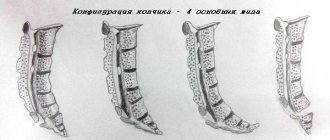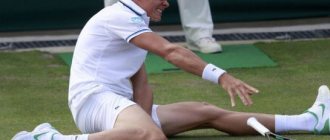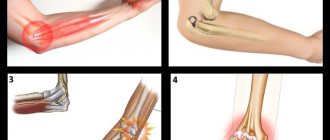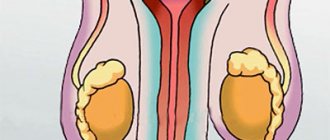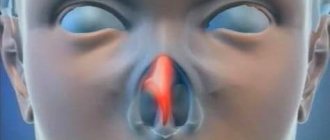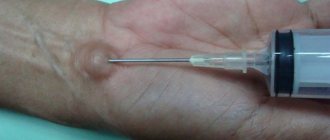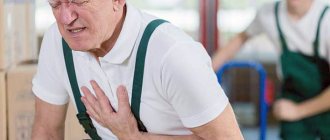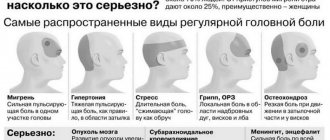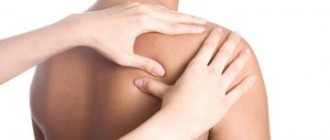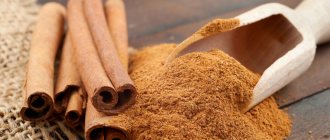In our article we will look at what to do if your knee joints hurt, how to treat them, and whether it is possible to get rid of discomfort in your knees forever - the last question is especially relevant for older people who consider inactivity and pain in the joints an indispensable accompaniment of age.
Causes of acute knee pain
The causes of acute, sharp, severe pain in the knee are very diverse. Conventionally, they can be divided into 2 large groups:
- Injuries.
- Diseases.
Injuries
Why does sharp, acute and severe pain appear after knee joint injuries? Damage is preceded by pressure, blow, bruise, fall, sharp turn or rotation of the leg.
These mechanical effects exceed the strength and elasticity of tissues. Under the influence of the applied force they are torn and destroyed. At the same time, the nerve endings that provide connection between the joint tissues and the central nervous system are damaged, and a signal of injury occurs—pain.
- A fracture of the bones of the knee joint occurs when the integrity of the bone tissue is damaged.
In addition to acute pain, during a fracture you can hear a characteristic cracking sound of bones and other tissues (ligaments, tendons). Massive swelling, hemorrhage in the tissue and cavity (hemarthrosis) quickly occurs, the outline of the knee joint changes (when bone fragments are displaced), and it is impossible to step on the leg. - Meniscal rupture is an injury in which the tissue of the cartilaginous plate bounding the articular surface of the tibia is damaged. Almost immediately, slight swelling appears, movements in the knee are limited or impossible (blockade).
- Rupture of ligaments and tendons occurs when the integrity of a large number of collagen fibers of which they are composed is disrupted.
Usually accompanied by damage to blood vessels, hemorrhage into the joint cavity (hemarthrosis), and impaired support function of the knee. When the collateral ligaments are torn, the knee becomes excessively mobile and “loose.” - A dislocation is an injury that occurs due to displacement of the articular surfaces (tibia, femur, patella) relative to each other.
Accompanied by damage to other soft tissues, changes in the contours of the knee, and if there is a strong displacement, it is impossible to step on the leg.
Click on photo to enlarge
Anterior cruciate ligament rupture of the knee joint
Post-traumatic knee pain is not related to illness. People who have:
- chronic joint pathologies;
- history of trauma;
- age-related changes in the strength and elasticity of tissues.
Diseases
The mechanism of the appearance of sharp pain against the background of various diseases has nuances, but it can be put into a simplified diagram:
- The tissues of the knee joint become inflamed under the influence of various factors - stress, medications, repeated injuries, infection of an open wound.
- Inflammation triggers numerous chemical reactions - the release of special inflammatory mediators (prostaglandins) and enzymes.
- Due to the changes that occur - impaired blood supply, permeability of vascular walls, accumulation of fluid in the area of damage - oxygen starvation of tissues, muscle spasms develop, and toxic products of cell decay accumulate.
- These substances together strongly irritate and damage nerve endings. At the moment when their number becomes critical, the central nervous system receives a signal about an acute process and transforms it into acute, sharp pain in the knee.
What pathologies can cause such pain?
- Arthrosis. Intra-articular cartilage loses its elasticity and strength and becomes loose, which over time leads to compaction, destruction and deformation of the bones of the joint. Exacerbation of arthrosis is characterized by the appearance of swelling, redness, local temperature, and stiffness of the knee.
- Arthritis. The symptom appears against the background of acute inflammation of the joint tissue, which can be caused by salt deposition (gout), infection, or systemic disease (rheumatism). Accompanied by redness, swelling, increased local temperature, and limited joint mobility.
- Acute bursitis, synovitis. Sharp pain occurs when the internal synovial membranes of the capsule (bursitis) and periarticular bursae (synovitis) become inflamed. A characteristic symptom is a large amount of fluid in the cavity or joint capsule, which is produced by irritated synovial cells. Severe pain in the knee can occur as a result of compression of nerve endings and blood vessels by accumulated fluid.
- Acute ligamentitis, tendonitis. The cause of sharp pain during ligamentitis (inflammation of the ligaments) and tendonitis (inflammation of the tendons) is associated with a violation of their free sliding, friction with surrounding tissues (tendon sheaths), and narrowing of the channels in which they pass. Pathologies occur with impaired mobility of the knee and can cause the development of contracture (improper fusion of tissues), fixation of the leg in a certain position (bent).
- Chondromatosis (appearance of nodules of cartilage tissue in the synovial membrane), chondropathy (malnutrition and necrosis of articular cartilage), osteochondritis (detachment of articular cartilage). With these pathologies, the elasticity of the joint membrane is impaired, and pieces of articular cartilage detach into the cavity. During movements, fragments and the articular membrane fall between the surfaces of the joint and block them (it is impossible to move the leg). At the same time, exfoliated and pinched tissues die, disintegrate, causing the development of acute inflammation and the appearance of edema.
- Circulatory disorders. In case of circulatory disorders, pain occurs from acute oxygen starvation of the periarticular tissues (ischemia). Ischemia can provoke the development of aseptic necrosis (cell death) with ongoing, severe and symmetrical pain in both extremities.
- Osteomyelitis (inflammation of the periosteum), phlegmon and abscess (these are purulent processes in soft tissues). The penetration of infectious pathogens is accompanied by acute inflammation, which quickly spreads to surrounding tissues. Characteristic symptoms are an increase in general and local temperature, bluishness and redness of the skin, accumulation of pus in the area of inflammation, and characteristic “tugging” sensations.
Click on photo to enlarge
Appearance of the knee with osteomelitis
The cause of severe knee pain can be sciatic nerve neuritis (inflammation of the nerve).
Who is more likely to injure their knee joints?
The knees are formed by several bones connected by muscles, ligaments, and tendons. There are also 5 synovial bursae - cavities surrounded by membranes designed to protect the joint. Between the joints of the bones there are interarticular cartilages - menisci, which help the knee to move freely. Disruption of even one area of the knee joint leads to the appearance of unpleasant symptoms.
Pain in the knee joint occurs especially often in people with flat feet. This is a foot pathology that disrupts the shock-absorbing capabilities of the limbs. With age, increased loads on the joints cause their destruction and the development of inflammatory phenomena - pain syndrome appears. Various types of deformities of the foot and lower leg have similar consequences.
There are a number of factors under the influence of which knee pain appears more often:
- Overweight;
- Passive lifestyle;
- High sports loads;
- Diabetes;
- Vascular diseases;
- Elderly age;
- Knee surgeries and injuries;
- Work with increased load on the legs.
The causes and treatment of knee pain vary greatly, as does the severity of the sensation. If your knee hurts badly, the cause may be an injury or an advanced stage of arthrosis, a severe inflammatory process. Sometimes the symptom becomes permanent, present even at rest, accompanied by swelling, redness of the skin, and crunching. All these signs should alert a person and force him to visit a doctor.
Pain due to bruises in the knee
Among the traumatic causes of joint dysfunction, bruises are the most common. Why does my knee hurt if the symptoms were preceded by only a minor bruise? Even a mild injury is accompanied by hemorrhage into the soft periarticular tissues and their swelling. As a result, the nerve roots suffer and pain appears.
In more serious cases, pain in the knee intensifies when bending and straightening the leg, and the person stops moving due to sharp sensations in the joint. On palpation, swelling of the leg can be noted; it is hot to the touch. How to treat such an injury? You should contact a traumatologist, take an x-ray, follow all recommendations and provide rest to your leg.
Often the cause of pain in the knee joint after a banal bruise is traumatic hemarthrosis. This is an outpouring of blood into the joint cavity, causing edema and swelling of the synovial membranes. As a result, the joint fills with blood and inflammation begins. Without proper treatment, an injury can result in the development of chronic arthrosis even at a young age.
Other types of knee injuries
If your leg hurts in the knee, and an injury contributed to these sensations, the reasons may lie in various damage to the components of the joint. Here are the main ones:
- Meniscopathy. Represents a flattening or tear of the meniscus. Injury is especially common in professional athletes, people involved in extreme sports, and also in household injuries. A person feels that the knee is sharply aching, the nature of the sensations is piercing, dagger-like, the joint loses mobility for some time.
- Ligament damage. A tear (sprain) of the ligaments occurs when the leg is twisted, after a jump, or when the limb is extended in an unnatural position. A sharp pain appears, the leg swells, the position of the joint changes, it becomes loose.
- Cruciate ligament rupture. Since these ligaments are located inside the joint, the injury often leads to bleeding into the knee cavity. Only a puncture will help pump out the blood and make an accurate diagnosis.
Aching pain in the knee joint sometimes accompanies chronic dislocations of the patella. Without treatment of acute injury, in a number of patients the dislocation becomes chronic and causes regular relapses. In children, this pathology causes an X-shaped curvature of the leg and leads to serious impairment of its function. Sometimes the pathology affects the knees on both legs.
Inflammatory diseases of the knees
Often, standard treatment for knee pain is ineffective. In this case, it may not be the joint itself that is affected, but the surrounding soft tissue. Thus, tendonitis, or inflammation of the tendon, can be triggered by increased loads on the limb, past leg injuries, allergies, reactions to medications, etc. With this disease, the knee joint hurts, as a rule, during the day or in the evening; the pain subsides at night. In the acute stage, joint mobility is severely limited, the syndrome is persistent and cannot be treated with ointments and creams. Sharp sensations are also observed when palpating the lateral part of the knee.
If your knees hurt regularly, the symptom worsens after hypothermia, the cause may be synovitis - inflammation of the synovial membranes. An inflammatory exudate appears inside the joint, which causes bursting and aching sensations. The causes of the pathology are varied:
- Autoimmune diseases;
- Metabolic diseases;
- Past traumas;
- Arthrosis.
Another “popular” disease that causes knee pain is bursitis. It occurs when the bursa (joint capsule) becomes inflamed. In addition to pain, redness, swelling, and increased sensitivity of the patella area are observed. If you do not clarify in time how to treat bursitis, it almost always becomes chronic.
Neoplasms of the knee joint area
Malignant tumors of this location are rare; pain syndrome is characteristic of them only at the very late stage. More often, aching pain in the knee joint is characteristic of benign formations:
- Baker's cyst. This tumor occurs under the knee, on its back surface. In appearance, the skin over the cyst is normal, not inflamed; when bent, there may be no swelling at all. In a standing position, a clearly defined, soft, elastic formation appears at the site of the cyst. It appears after a unilateral knee injury or cartilage damage. Very often the cyst accompanies chronic synovitis, arthrosis, rheumatoid arthritis. Large cysts cause not only pain in the knee, but also serious limitation of limb mobility. Due to compression of blood vessels and nerves, other symptoms include cold skin, pallor, goosebumps, and numbness.
- Meniscus cyst. Appears in the external or internal meniscus when a cavity with fluid is localized inside the cartilage. In this case, the knees hurt after high loads or at the end of the day. Large cysts may be visible on the lateral part of the joint, small ones are visible only by ultrasound or x-ray.
A rare pathology is Hoffa's disease - transformation of the fatty tissue of the joint, which becomes fibrous and causes dysfunction of the joint. Against the background of this pathology, arthrosis often develops, which provokes pain in the knee joint. Reasons: hormonal imbalances, menopause in women.
Infectious joint pathologies
Against the background of infection, the knee joint hurts sharply, sharply, providing rest does not relieve the condition. Even urogenital and intestinal infections can cause complications on the musculoskeletal system, resulting in reactive arthritis. Bacteria (salmonella, chlamydia, gonococci and others) penetrate into the cavity of the bone joint with the bloodstream, settle on the tissues and cause inflammation. The tendons usually become inflamed too, causing the knee to become swollen and hot to the touch.
Tuberculosis is a serious disease. Mycobacterium tuberculosis multiplies in bone tissue, causing bone melting and necrosis of cartilage and soft tissue. Without emergency treatment, the knee joints hurt and collapse, and the process covers increasingly larger areas. As a result, fistulas appear - cavities with pus, which can pour out and cause damage to the entire body.
An acute, urgent disease is osteomyelitis of the bone. What to do if your knees hurt, and the process is accompanied by weakness, muscle aches, and fever up to 40 degrees? If the pain in the knee is boring, bursting, and the tissues themselves are swollen, red, and blue, you should urgently call an ambulance and go for emergency surgery. Otherwise, you may lose your leg or die.
Knee pain – causes of degenerative nature
After the age of 50, a huge number of people have knee pain. The prerequisites are the aging of the body, wear and tear of the joint apparatus and the development of the most common pathology - osteoarthritis (gonarthrosis). It leads to thinning and destruction of cartilage with a change in the shape of the bone heads. Most often, at the early stage of the pathology, the knee aches on one side; after a few years, the lesion becomes bilateral. Stiffness in my leg bothers me in the morning, but it goes away quickly. Increased sensations are possible after physical work, intense sports, or long walking.
At advanced stages, articular tissues collapse, and osteophytes grow to the sides of the joint space. These are spines made of bone tissue, which in severe cases break off and cause unbearable pain. There are a number of other degenerative pathologies, the symptoms of which will be similar to gonarthrosis:
- Osteochondropathy. Affects the articular surface of the bone, associated with injury and sports. It can develop in teenagers for no apparent reason.
- Arthritis. It can be rheumatoid, psoriatic, gouty, and provokes chronic inflammation and joint destruction.
- Chondromatosis. The etiology is unclear. The disease causes the appearance of nodes on the synovial membranes, which limit the movement of the knee and cause pain.
Women in menopause often have knee pain due to osteoporosis - thinning of the bones, increasing their fragility. The disease is accompanied by leg cramps, pain in the spine, and periodic fractures.
Other causes of knee pain
When your knees hurt, the etiology of the sensation may also lie in damage to the peripheral nervous system. Thus, neuropathy of the sciatic nerve against the background of damage to the lumbar vertebrae leads to a number of symptoms. A person’s knees ache, the hip area ache, the joints of the limbs weaken, and skin sensitivity is impaired. Leg reflexes also change.
Sometimes the entire knee joint hurts due to vascular disorders. Only in adolescence should you not worry too much - due to the rapid growth of the body, the vessels do not have time to supply the bones with blood. With age, the condition of the joint normalizes - usually by the age of 18-20 the pain completely stops.
In old age, with atherosclerosis, knees also often hurt, what to do in this case? Without normalizing fat metabolism, plaque will continue to be deposited inside the arteries. The vessels become clogged and stop supplying the joint fully. Arthrosis develops in it, and the pain becomes chronic. Unpleasant sensations in the knee area can also be caused by varicose veins, thrombophlebitis, and vascular thrombosis.
Characteristic symptoms, possible complications of pain
Acute pain in the knee is not a pathology, but one of the main symptoms that signals serious disorders and damage to the tissues of the knee.
Regardless of the cause, a person with pain usually takes care of their leg so as not to provoke additional injury or attack. He is unable or unwilling to move, lean on the limb, bend and straighten it.
The most characteristic signs of the causes of acute pain are listed in the section above. In 90% of cases, common signs of injuries and acute conditions are:
- swelling;
- swelling, change in the contours of the knee;
- impaired range of motion, stiffness to complete immobility;
- change in skin color (bruising, redness, pallor);
- increase in local temperature (skin is hot to the touch).
Any acute process can cause all sorts of complications:
- Arthrosis is the gradual destruction of a joint.
- Arthritis is inflammation of the joint.
- Contractures are fixations in a certain position due to improper fusion of inflamed tissues.
- Stiffness of the knee - due to tissue ossification.
- Joint laxity – when ligaments and tendons are torn.
- Purulent melting of tissues – during an infectious process.
Swelling and purulent melting of the tissues of the knee joint
When purulent melting of surrounding tissues and infection enters the bloodstream, general inflammation of the body (sepsis) can occur. In most cases it ends in death.
Painful effect when pressed
If the effect appears precisely when pressed, then we are talking about a serious inflammatory process, for example, bursitis . The same symptom is characteristic of injuries. Often, when pressure is applied, a dull pain begins to occur; this manifestation indicates problems with the meniscus, which means you need to immediately contact a specialist for advice and diagnostics.
Bursitis
With gout, discomfort is also clearly manifested precisely when pressed; at rest it is practically absent.
Gout
Diagnostics
A preliminary diagnosis can be established during a survey and examination of the patient, based on the appearance of the knee, the nature of the pain and other associated signs.
Diagnosis based on the nature of pain:
| Disease | Description of pain in the knee |
| Rupture of menisci, ligaments and tendons | Sudden throbbing pain gradually subsides at rest and resumes when bending or turning the leg |
| Fracture | Acute pain immediately after the injury, when trying to step on the leg and put pressure on the affected area |
| Knee dislocation | Severe, persistent pain, changes in the contours of the joint - displaced parts bulge, protrude above the surface |
| Exacerbation of arthrosis | Sharp dull pain against a background of constant, aching pain, crunching and stiffness in the joint after exercise and in the morning |
| Osteochondritis (Konig's disease) - occurs when fragments of cartilage tissue are pinched between the articular surfaces | At this moment, the leg “gets stuck” in a certain position, and when you try to move it, a cutting pain occurs |
| Rheumatoid arthritis | Sharp, sharp, burning pain in several joints at the same time (for example, in both knees) |
| Acute purulent inflammation | Throbbing, jerking pain |
The diagnosis is confirmed after:
- diagnostic tests - allow you to clarify the nature of the damage and the cause of pain;
- instrumental studies (radiography, MRI, ultrasound, CT, arthroscopy, puncture);
- laboratory tests (blood tests for rheumatoid factor, C-reactive protein, analysis of fluid extracted from the joint, for pathogenic pathogens, etc.).
MRI of the knee joint
Knee pain in older people
Patients of this age often complain of pain in the joints, which is associated with a number of reasons, the main one of which is the wear and tear of cartilage and bone tissue, which causes them to become deformed. In addition, joint diseases can be caused by:
- Overweight.
- Staying in an unnatural position for a long time (sitting, standing, crossing your legs, etc.).
- A diet that lacks (or is present in small quantities) minerals.
- Excessive physical activity, which leads to injuries and further destruction of the joint structure.
- Inappropriate or uncomfortable shoes (high heels, tight models, etc.).
Often patients try to treat the knee joint with folk remedies, which does not always give the desired effect. It is best to use a set of therapeutic measures prescribed by a doctor.
diagnosis can only be made after a thorough medical examination
First aid for injuries
First aid should be provided to the victim if the knee hurts due to injury.
| What should be done | What not to do |
| Lay the victim horizontally | Move, step on your foot |
| Place a small cushion under your shin and knee (to reduce swelling) | Rub, warm and massage the joint |
| Apply ice to the knee (for 20 minutes 5–7 times during the first 24 hours after the injury) | To realign protruding parts of the knee (in case of dislocation) or bone fragments (in case of open fracture) |
| Apply a splint (place a long stick or umbrella on the outside and side of the leg, wrap it with bandages 20 cm above and below the knee) or a fixing bandage | Unbend, straighten the knee if it is fixed in a certain position |
| In case of unbearable pain, the victim can be given an anesthetic drug (Ketanov) |
Fixation of the knee joint
Constantly
Ligament damage. Occurs after injuries and falls.
An anterior cruciate ligament rupture is characterized by a characteristic crunching sensation at the knee followed by severe pain, swelling, hemarthrosis, and limited flexion.
As a rule, one knee is affected - left or right. With a complete rupture, stability is lost, the knee loses its ability to support body weight and takes an unnatural position;
Extension of the knee joint. As a result of the pathology, the knee expands and bends in the opposite direction. Accompanied by swelling and dangerous ligament rupture;
Septic or rheumatoid arthritis. Causes deformation of the joint, in which persistent malaise, fever and stiffness of movement are noted;
Osteoporosis. Its appearance is associated with age, while the cartilage loses its elasticity, the joint ceases to function normally and hurts with varying intensity;
Gout is characterized by sudden increases in pain, flushing, and signs of swelling with bright red skin above the knee.
It is caused by metabolic disorders, due to which there is an excessive concentration of uric acid in the blood.
Treatment methods
Severe, sharp, acute pain in the knee joint can be eliminated in 70% of cases. After treatment, the pain goes away completely and without consequences. Or it becomes dull, becomes chronic and bothers the patient during exacerbations, during stress, and active movements.
Therapy depends on the specific cause of the symptom:
For injuries
- Painkillers and anti-inflammatory drugs are prescribed.
- They perform a puncture to remove fluid from the joint and surrounding bursae.
- They restore the integrity of damaged tissues - they combine bone fragments, clean off exfoliated articular surfaces, sew together ligaments, menisci, and tendons.
The leg is kept immobilized (plaster or splint is applied) for the entire healing period.
Knee joint puncture
With exacerbation of chronic processes (arthrosis) and arthritis
- First, anti-inflammatory, painkillers and drugs that suppress the activity of the immune response are prescribed for rheumatoid diseases.
- Then a long course of chondroprotectors is prescribed, which stops the destruction of cartilage.
During treatment, the load on the joint is reduced as much as possible.
For purulent infections (purulent arthritis)
- The joint capsule is cleaned of pus and melted tissue and washed with antiseptics.
- A course of antibiotics, anti-inflammatory and painkillers is prescribed.
For aseptic bursitis, synovitis
- A puncture is performed (fluid is removed).
- The cavity is washed with antiseptics.
- Apply a tight, compressive bandage, reducing the load on the joint.
The duration of treatment depends on the form of the disease and the degree of tissue damage. A mandatory stage in the treatment of any joint pathologies is a course of physical therapy during the recovery period.
Prevention (gymnastics, nutrition)
What can help if changes in the joint have just begun or have not yet begun? Timely adoption of preventive measures:
- Regularly perform therapeutic exercises, swim, do yoga, and walk more. Sports and walks in the fresh air will help strengthen the ligaments and muscles of the joint, and get rid of pain in the knee joint when walking. With moderate, and most importantly, correct load, blood circulation increases, the composition of synovial fluid and the nutrition of articular cartilage improve. This stops the aging process and tissue destruction.
- Wearing protective orthoses and braces at moments of maximum stress, as well as comfortable, flat shoes, will help protect the knee from injury and damage.
- After 45 years, any load should be moderate. If necessary, they need to be increased gradually.
- An excellent prevention of premature aging of cartilage is courses of therapeutic massage, which must be repeated at least 2 times a year.
They reduce the appearance of cellulite, increase blood supply to periarticular tissues, stimulate the drainage of lymph and accumulated toxins.
Protective knee orthosis
To prevent joint diseases, it is necessary to promptly diagnose and treat diseases that can affect the development of joint pathologies - remote foci of infection, allergies.
Principles of proper nutrition
For the prevention of joint diseases, a balanced, proper diet is especially important. It will help you lose excess weight and reduce stress on the joint.
It is necessary to include foods that are beneficial for bones and cartilage into the diet - sources of amino acids from which the collagen molecule is formed:
- edible gelatin solution, products with gelatin;
- strong bone beef broth, jellied meat;
- red fish (chum salmon, pink salmon, trout);
- avocado;
- soy protein and soy products (tofu, soybean oil).
Foods high in vitamins:
- D – fatty varieties of sea fish, eggs, butter;
- C – citrus fruits, berries, white cabbage;
- PP – cheese, chicken, fish;
- A – sea fish, milk, red vegetables;
- B – nuts, seeds, cereals, liver, fresh vegetables and fruits;
- E – vegetable oils, beans, cereals.
Foods rich in microelements:
- Calcium – cheese, cottage cheese, dairy products.
- Magnesium – sesame seeds, cashew nuts, almonds.
- Phosphorus – cottage cheese, cheese.
- Sulfur – all types of cabbage, green vegetables.
- Copper - nuts, raw yolk.
Without vitamins and microelements, metabolism and nutrition of periarticular tissues deteriorate, bone fragility increases, toxins accumulate, and damaged cartilage cells renew more slowly.
How to relieve severe knee pain
How to get rid of sharp, severe pain in the knee using home and folk remedies? In 95% of cases, such a symptom is a sign of an acute process, so if pain occurs, you should immediately consult a doctor.
It is better not to use folk remedies and medications from the home medicine cabinet at this moment. Sometimes even taking analgesics can work against the body - the pain is dulled, but the cause does not disappear.
Pathology or injury can become complicated into a chronic process, which is much more difficult to get rid of.
An exception is taking analgesics (Ketanova) and an ice compress immediately after an injury. These means can reduce pain and avoid painful shock until doctors arrive (calling an ambulance in case of injury is necessary).
If the cause of pain in the joint is established, the disease is in remission (proceeds with mild symptoms), then for arthritis, arthrosis, radiculitis, rheumatism, some folk remedies can be used:
- prevent exacerbation of the disease;
- relieve sharp, severe knee pain;
- get rid of residual signs of pathology.
Recipes for folk remedies for joint pain:
- Ointment with cinquefoil. Take 5 tbsp. l. cinquefoil alcohol tincture, 1 tsp. camphor alcohol, tincture of hot red pepper, honey and 50 ml of goose fat. Melt the fat and stir in all the ingredients. After cooling, apply to the knee. Repeat the procedure 2-3 times a day. Duration of treatment is up to 4 weeks. After a 10-day break, it can be repeated.
- Oil balm with golden mustache. Take fresh stems and leaves of golden mustache (Callisia fragrant), grind in a blender or mortar. Pour ¼ cup of the resulting mass with 1.5 cups of any vegetable oil, add 20 drops of vitamin E oil solution. Leave in a dry, warm place for 3-4 weeks, shake regularly. Rub the balm on the sore knee 1-2 times a day until the disturbing symptoms completely disappear.
- Compresses with Dimexide. Dilute pharmaceutical Dimexide with water in a ratio of 1:6. Make a compress with the resulting solution once a day, apply for 1.5–2 hours. Duration of treatment is 10–12 days. After 10 days you can repeat the course.
The Golden Usher plant is used to prepare an oil balm for knee pain
However, it is better to first coordinate all methods of home treatment for the knee joint with your doctor.
https://www.youtube.com/watch?v=annNhntRncE
Rheumatoid arthritis and its treatment
There are often cases when knee pain is caused by rheumatic diseases. One such manifestation may be rheumatoid arthritis of the knee. Arthrosis is also possible. This type of disease, rheumatoid arthritis, occurs when the joints of the legs become inflamed and caused by disorders of the immune system. This pathology can occur in any age category. With arthritis, inflammation occurs in the kneecap area. Pain is accompanied by increased swelling of the joint and high subcutaneous temperature.
Basically, knee pain is felt when moving (walking or bending the joint). Treatment of rheumatoid arthritis (arthrosis) involves the use of non-steroidal drugs that will help relieve pain, as well as reduce the inflammatory process in the damaged area. Traditional methods of treatment at home, therapeutic exercises and massage are good preventive actions to restore bone structure.
The knee is a kind of shock absorber to soften the load from a person’s steps
If you experience pain under or above the kneecap when walking or bending your leg, you should consult a doctor immediately. Only a highly qualified specialist can establish the causes and correct diagnosis. Self-medication can lead to serious consequences.
Prognosis for recovery
Severe, sharp pain in the knee is a sign of serious damage, injury, or worsened disease. In most cases, it is possible to get rid of this symptom by eliminating the cause using conservative or surgical treatment.
Methods, terms of treatment and rehabilitation depend on the cause of knee pain. Recovery after a ligament rupture or dislocation can take from 4 weeks to 2 months, after a fracture – up to 6 months.
Acute aseptic bursitis and synovitis are successfully cured in 2–4 weeks. It is impossible to completely recover from arthrosis and rheumatoid arthritis. The process can only be stopped - through prevention, taking medications, and physical therapy exercises.
Treatment
The first task when pain develops above the kneecap is to reduce physical stress on this area. If the pathological process occurs without swelling, burning, or severe pain, you should adhere to minimal physical activity. Acute pain syndromes require bed rest. When walking, it is recommended to use a cane, crutches, and orthopedic shoes.
Often the disease can be cured using conservative methods. This technique blocks pain and eliminates swelling during acute pathology. After these procedures, mobility and stability of the knee joint are restored.
Traditional methods
Traditional methods include drug therapy. Non-steroidal anti-inflammatory drugs are injected into the joint. It is often practiced to administer analgesics that relieve physical discomfort. When the pain is more in the front of the cup, applications are used. To restore elasticity and restore the integrity of the meniscus, chondroprotectors are injected into the knee joint.
Physiotherapy is used in combination with other treatment methods. It must be carried out regardless of the manifestation of pain on the left or right. Physiotherapy is effective in pain relief. It improves and normalizes blood flow to the affected area, eliminates the anti-inflammatory process.
It is important to understand that a combination of procedures leads to an effective solution in getting rid of pathology. Specialists prescribe procedures based on the results of tests and studies
In this case, the age of the patient must be taken into account.
Folk remedies
There are cases when patients try to cope with pain above the kneecap on their own, which is strictly prohibited. Traditional medicine has a beneficial effect on pathology in combination with drug treatment. Before using folk remedies, you need to consult a qualified specialist so that the treatment does not aggravate an existing pathological process.
- To eliminate pain, it is recommended to use burdock juice mixed with vodka 1:1. This infusion is used to rub the sore knee. You can apply a compress at night.
- Birch leaves relieve pain and swelling. They should be washed under running water, applied to the knee and wrapped in a warm towel. The compress is applied during the rest period.
Traditional medicine has many recipes. But it is important to remember that the human body is individual, and what helps your family and friends can harm your health.
Main causes of pain
Quite often, pain in the kneecap is a consequence of tendonitis. Here we can immediately note the following features of the problem:
- The pain intensifies with physical activity.
- Inflammation appears if the knee has been injured.
- Tendenitis can develop against the background of rheumatic factor.
Pain in this disease occurs when doing flexion and extension. During these movements, you can clearly hear a creaking sound in the area of the kneecap.
Doctors often suggest doing knee blocks using intra-articular injections into the knee joint. In addition, the problem can be eliminated with physiotherapeutic procedures. Only in extremely rare cases is it necessary to undergo surgery.
The next reason that leads to pain in the kneecap area is damage to the meniscus.
The meniscus can be considered as a natural shock absorber that nature has endowed a person with, and the meniscus helps transfer loads to the joints.
If the problem is a damaged meniscus, then the pain will be dull and there will be a limitation in the motor function of the knee.
X-rays and MRIs of the knee joint help to accurately diagnose the severity of meniscus damage, on the basis of which a diagnosis is made and treatment is prescribed.
From a treatment point of view, it can be clarified that modern orthopedics has reached heights in the treatment of rupture and other meniscus injuries. Several types of surgical intervention are performed, from suturing the meniscus to its complete removal.
If the situation is critical, partial or complete replacement of the meniscus or knee joint is performed.
It is important to emphasize here that it will be necessary to take the recovery period extremely responsibly; the subsequent condition of the kneecap depends on this.
Night pain in knee joints
If discomfort during the day can be explained by excessive exertion, then what about the fact that your legs ache below the knees at night? The reasons for this phenomenon may also be different. In some cases, they are associated with muscle diseases, sometimes with impaired blood supply or innervation. Aching pain is often accompanied by cramps or unpleasant twitching of the legs. Naturally, such symptoms interfere with normal sleep. To deal with this problem, you should consult a doctor. In some cases, pain occurs due to a deficiency of microelements in the body. Among them are calcium and magnesium.
Women more often complain that their legs ache below the knees at night. Hormonal changes may be the cause. With a lack of estrogen, calcium levels noticeably decrease, resulting in discomfort in the leg muscles. A decrease in the amount of female sex hormones occurs during pregnancy, lactation and menopause.
Wearing high-heeled shoes all day also causes pain below the knee in the evening and at night. To prevent serious blood supply problems from developing, you should change your shoes. The causes of discomfort below the knee include varicose veins and other vascular pathologies. To identify them, you should do an ultrasound of the arteries and veins of the lower extremities with Doppler ultrasound.
How to help your feet?
If you experience pain in the patella, even if the pain is not obvious, you need to consult a specialist, he will decide what to do. Often the diseases are chronic and can gradually, without any special signs, destroy the joint.
To make a diagnosis and get a more comprehensive picture of the pathology, the doctor will need the following results:
- Ultrasound;
- MRI;
- X-ray;
- puncture of the contents of the bursa;
- blood and urine tests.
Read also: What to do to prevent your knees from hurting
Only after a complete examination of the patient will it be possible to talk about the choice of therapy.
Initially, to prevent pain, the diseased joint is immobilized - a plaster cast, an orthosis or a pressure bandage is applied.
Then, based on the examination data, drug treatment is prescribed:
- Antibiotics. They are used for infectious bursitis, arthritis, and arthrosis. Before prescribing medications, a test is carried out to determine the tolerability of the drug and its effectiveness.
- Anti-inflammatory. The first days use steroid drugs, possibly injections or tablets, then use non-steroidal anti-inflammatory drugs.
- Medicines that improve blood circulation, vitamins. They are used to speed up joint recovery.
- Chondroprotectors. Drugs to stop regression in bone and cartilage tissue are used quite often for chondropathy and tendon ruptures.
Pathologies such as patellar instability are usually not treated with medications; exercise therapy and massages are used to strengthen the muscle corset, which will not compromise the integrity of the joint.
In some cases, they resort to the services of a chiropractor who will help move the components of the joint into place.
A physiotherapist will help improve the outcome of your medication. For example, the following methods are used:
- ultrasound;
- paraffin therapy;
- magnetic therapy;
- mud treatment.
Such methods will reduce pain and improve blood microcirculation in the problem area.
Find out about ointments for joints here.
In extreme cases, if the ligaments are torn and treatment is not effective, the help of a surgeon is needed, who will perform operations to eliminate the inflamed area of the bursa, replace the patella with an implant, or completely replace the joint.
The patella has an important function for the musculoskeletal system; the knee joint constantly experiences heavy loads.
In more than 50% of cases of knee joint diseases, the kneecap is affected. It is important to maintain the health of all components of the knee. Moreover, it is so simple if you contact a rheumatologist in a timely manner and his competent approach to therapy.
If you find an error, please select a piece of text and press Ctrl+Enter.
Why does pain occur under the knee?
- Pain under the knee impairs the mobility of the joint. The knees bend poorly and stiffness appears. The joint becomes red, swollen and hot. In the morning the pain is stronger, in the afternoon it subsides. These are signs of arthritis.
- The cause of pain under the knee is previous or previous injuries. These can be dislocations, ruptured ligaments and menisci, sprains, and fractures. They are usually caused by a fall or injury. The site of the injury swells and a bruise forms. The person feels weak and freezes. The under knee feels numb and tingling.
- Overuse injuries occur when you repeat the same movements on a joint over and over again or put pressure on it for a long time. If a person climbs stairs, rides a bike, runs or jumps many times every day, his knees hurt a lot. What to do when a heavy load leads to inflammation of the joints and periarticular tissues? First, you need to reduce the load on your joints and give them the opportunity to rest. If the pain does not stop, you should consult a doctor.
- A Baker's cyst can cause pain behind the knee.
- An infection in the bone, skin, or bursa causes pain behind the knee and limits movement.
- Osteochondritis dissecans often causes popliteal pain that limits movement. This occurs when there is no blood flow to a small area of bone or cartilage inside the joint. He is dying.
Pain under the knee on the back surface
Pain at the back of the knee is an indicator of inflammatory and other pathologies in the soft tissues of the knee joint and nearby tissues.
Pain behind the knee due to:
- Synovitis with effusion in the posterior region of the joint capsule.
- Bursitis of the calf or popliteus tendons.
- Rupture of the posterior horn of the meniscus.
- Cyst formation in the posterior horn of the meniscus.
- Abscess in the popliteal fossa.
- Vein thrombosis or arterial aneurysm.
Synovitis, bursitis and Baker's cyst
The result of the accumulation of excess fluid during synovitis or bursitis can be a Baker's cyst - the formation of a pocket on the synovium or bursa, protruding under the knee in the form of a ball.
Symptoms of a popliteal cyst:
- pain behind the knee when bending;
- swelling;
- circulatory disorders in the sore leg.
Symptoms of a ruptured cyst:
- a sharp increase in pain and swelling, to the point that the entire lower leg may swell;
- redness, burning sensation under the knee;
- temperature increase.
For moderate symptoms, conservative treatment is possible:
non-steroidal and hormonal anti-inflammatory drugs (diclofenac, movalis, ketonal, hydrocortisone, dexamethosone).
If this treatment does not help, it is recommended:
- Puncture with washing the cavity with antiseptic drugs.
- Development of a regimen of anti-infective or anti-inflammatory therapy based on the analysis of synovium.
- Laser coagulation of a cyst.
It is necessary to treat a rupture of Baker's cyst only by surgery, by removing part of the synovial membrane of the knee joint.
Pathologies of the meniscus (cyst, rupture)
A cyst or tear located in the posterior horn of the meniscus can lead to severe pain during movement, when straightening or bending the knee.
It is not always necessary to resort to surgery in these cases - you can limit yourself to:
- anti-inflammatory therapy during painful attacks;
- wearing an elastic bandage during exercise.
The operation must be resorted to:
- with significant restriction of movement or blocking of the joint,
- progressive growth of the cyst;
- presence of large effusion.
Abscess, aneurysm and thrombosis
An abscess in the popliteal fossa is caused by direct infection from nearby wounds, or by distant infection traveling through the lymphatic and blood vessels.
There is only one way out - immediate removal of the abscess and installation of drainage.
Aneurysm and thrombosis may be practically invisible outwardly, which is why they are dangerous. With these pathologies, the following may be observed:
- popliteal artery pulsation;
- nagging pain behind the knee;
- the legs become very swollen - a symptom of popliteal vein thrombosis;
- Trophic disorders begin on the skin of the legs.
Treatment is surgical.
Schlatter's disease
This disease leads to circulatory problems in the knee joint due to destruction of the bone core. Against the background of a decrease in blood flow, an inflammatory process develops in cartilage and bone tissues. As a result, the kneecap will hurt. It is impossible to eliminate such pain without medical intervention.
Causes
The following factors can provoke the appearance of knee problems and the development of the disease:
- broken bones in the knee;
- dislocated knee;
- joint bruise;
- professional sports.
Against the background of degenerative age-related changes in the kneecaps, this disease does not develop.
Symptoms
Pain in the kneecap, which increases significantly with movement, is one of the first manifestations of the pathology. Then it is accompanied by swelling in the morning and after active sports, as well as persistent swelling in the area of the kneecap.
Treatment
If you seek medical help in a timely manner, you can cope with the problem using only conservative methods of therapy. It is mandatory to remove the load from the knee and use a special bandage that reduces the mobility of the joint. Medications include painkillers and non-steroidal anti-inflammatory drugs. Massage and physiotherapy are also available.
Surgical intervention is required if the pathology does not go away after prolonged medical treatment, when the patella hurts especially severely, there is often a pronounced change in and around the joint. The intervention falls into the light category. It takes a short period of time to recover from it. Pain when pressing on the kneecap as a residual phenomenon may persist for several weeks.
Rheumatoid arthritis
Rheumatic factors occupy one of the main places in the appearance of pain in the knee area. Another common factor is rheumatoid arthritis of the knee joint.
- RA occurs when the joints of the legs and knees become inflamed.
- This disrupts the functioning of the immune system.
- Ra develops at any age and can affect both children and adults.
- The inflammatory process covers the patella and knee joints.
- If you do nothing, swelling of the knee appears along with pain.
- At the site of inflammation, the local temperature increases.
Read also: Synovitis of the knee joint - what is it?
Non-steroidal anti-inflammatory drugs are used as drugs for the treatment of RA. As for folk, non-traditional methods of treatment, exercise therapy, they can be used as additional options in complex therapy.
Therapeutic exercise for joint pathologies
What else can you do if your knees ache? You should ask your doctor about the causes and treatment of joint diseases using non-drug methods. To reduce the intensity of discomfort and prevent complications, various exercises are prescribed. These include bending and straightening the knees, rotating joints, and squats. It is worth remembering that heavy loads are contraindicated. Exercises should not be done if there are bone fractures or in the postoperative period. If the pain is caused by chronic destructive pathologies, physical therapy in the early stages is very important. It allows you to slow down the pathological process for a long time.
Nature and localization of pain
The kneecap (patella) helps protect the entire knee joint from severe damage and serves as protection against displacement of the femur and tibia. When walking and any other movement, the patella is able to move, still protecting the bones of the joint, thanks to the tendons.
Due to the functions assigned to the patella, it is the one that suffers the most in the knee joint, and the pain can be both pulling and sharp, radiating throughout the entire limb or focused only in the joint.
The most common answer to the question of why the kneecap hurts, in 75% of cases, is considered to be injury or overexertion, for example, due to constant kneeling.
Important! When the patella is fractured or bruised, the pain is sharp, sharp, and the joint swells.
However, trauma is not the only problem that causes pain in the kneecap; what else can cause discomfort?
Patella instability
The patella must move when functioning along the condyles of the bones; the recess of the patella exactly coincides with the dimensions of these condyles. If the patella is in an incorrect position (in case of subluxation, tilting or dislocation) or hypoplasia of the condyles themselves, when they are significantly smaller than the recess, they speak of patellar instability.
In most cases, a person experiences pain spread throughout the entire knee area of the limb. It is not uncommon to experience pain under the kneecap.
Another characteristic sign of instability is a crunching sound when bending the joint.
For reference! It is the instability of the patella that can cause the development of arthrosis and synovitis.
Chondropathy
The layer of cartilage tissue that is present in the patella can be damaged, then the quality function of the joint is disrupted - the bones, left without a cartilage layer, begin to rub against each other when the limb is bent, causing discomfort, and unpleasant friction is felt. When walking, a person feels pain under the patella, it is bursting, pressing.
Then, when in the same position, a person, inactive, may feel severe pain in the same area.
In extreme cases, a person already feels pain under the patella constantly, and it intensifies significantly when the joint is flexed.
Apart from pain symptoms, there are no other identifying signs.
Inflammation of the patellar tendon can also cause pain. A person, first after loading the joint, and then during it, experiences an unpleasant sensation in the lower part of the patella, this sensation turns into an increasing dull pain under the kneecap or nearby. The pain intensifies when pressing on the kneecap.
The function of the joint gradually decreases, the person feels weakness in the limb, discomfort when bending.
Carefully! Tendinitis, as it develops, will lead to rupture of the tendon, then severe swelling will be added to the pain.
We are talking about prepatellar bursitis - an inflammatory process of the largest bursa covering the patella.
In this case, the person experiences acute pain during flexion and extension, which intensifies with pressure and palpation. He cannot stand on his affected knee.
Also a clear sign of prepatellar bursitis is swelling, swelling on top of the patella.
Important! If the source of all troubles is infection, redness of the patella area and an increase in local and general body temperature are possible.
Retropatellar arthrosis – women housewives suffer the most from this disease. For various reasons, a disease that has developed behind the patella prevents both knees from functioning normally.
The pain is not particularly obvious at first, but intensifies when walking up stairs, squats, or kneeling for a long time.
Crunching and friction are possible; at a later stage, during palpation, the edges of the bones are invisibly felt, and deformation of the limb begins.
The inflammatory process of the intra-articular tissue or periarticular tissues of the knee joint is the reason why the knee hurts.
In addition, a person cannot help but notice the development of severe swelling of the knee joint and an increase in temperature.
The movements of the limb become more and more constrained, the pain intensifies when walking up the stairs or any other movement.
For reference! Arthritis often harms other internal organs.
Pain under the kneecap: why it hurts, what to do for knee pain
Pain above the kneecap is a fairly common sensation in the knee joints. This is primarily due to the fact that the skeleton, joints, and muscles constantly experience stress throughout a person’s life.
When walking, exercising, running, climbing stairs, you may feel like your knee is hurting, and the nature of the pain varies.
At the same time, if the pain begins to be localized specifically above the patella and in the knee area, it should not be ignored.
The question of why pain occurs here is usually answered in the form of consequences of injury, mechanical damage, but there may also be reasons that indicate certain diseases.
Let's look at what can be lasting if knee pain begins to appear on an ongoing basis.
Constant pain
Constant pain in the kneecap is a fairly common phenomenon and can be caused by traumatic bone injuries, ligament ruptures, joint enlargement, various types of arthritis, osteoporosis, gout and advanced arthrosis.
Patella injury. A direct blow or fall on the knee leads to damage to the patella itself, that is, the bone. Cracks or fractures may appear in it. With such injuries to the kneecap, a person experiences sharp, constant pain. In this case, the knee rapidly swells, reactive inflammation and hemarthrosis occur. The pain syndrome is less pronounced in the presence of cracks in the bone. When a complete separation of part of the patella occurs, displacement or crushing of the bone, the pain is pronounced, which intensifies when bending or trying to step on the leg.
Ligament damage. Rupture, tear, and sprain of the ligaments are associated with knee injuries after falls, rotational unnatural movements of the leg, direct blows and increased loads. When the ligaments are stretched, the pain appears burning, sometimes unbearable. This pathology is accompanied by severe swelling and limited leg mobility. If the ligament is completely torn, the knee loses stability and assumes an unnatural position. In this case, the pathology can often be accompanied by dislocation of bones and damage to the menisci.
Osteoporosis. A disease that is primarily associated with age-related changes in bone structure. But there are many more reasons for the appearance of fragility and porosity of bones and, first of all, this is lifestyle, lack of physical activity and deficiency of elements necessary for bones. Therefore, young patients also face bone fragility. This deviation in the structure of bone tissue is accompanied by aching pain that worries a person constantly.
Arthritis. An inflammatory type disease. Most often it is chronic. At the same time, the patient’s knee pain is constant and debilitating. Diseases of the rheumatic or septic type are especially painful. In this case, joint mobility is limited, and inflammation is accompanied by swelling and accumulation of effusion.
Gout. Another specific type of arthritis, in which relapse occurs completely unpredictably. With exacerbation, the pain intensifies significantly, the skin above the knee turns red. The pain is almost unbearable, both at rest and with any movement. The crisis can last from several hours to 10 days. Even intensive treatment does not always bring significant relief. The pathology is associated with metabolic disorders accompanied by the accumulation of uric acid. Therefore, treatment must be specific. Standard painkillers and anti-inflammatory treatment regimens are powerless here.
Types of pain, what diseases they correspond to
For each pathology or injury, knee pain is specific. In many cases, doctors diagnose the pathology based on the nature of the pain syndrome. Let us describe the specifics of pain in various knee diseases.
Aching
Aching pains have bothered almost every person in this life. They can occur after intense physical exercise. stress, overwork. Often aching pains are not provoked by physical pain. load. They can occur at night when the weather changes. Aching pain may indicate the development of the following diseases:
- Arthritis;
- arthrosis;
- tendinitis;
- Baker's cyst;
- allergies to medications;
- joint infections due to gonorrhea, tuberculosis, syphilis.
Sharp, strong
Severe pain when straightening the leg can be caused by various reasons. Sharp pain usually accompanies injury. Acute pain that intensifies after walking indicates the presence of inflammation of the tendons, joints, muscle fibers, and ligaments.
The most common causes of severe pain are:
- Sprains, ligament tears;
- bone fractures;
- tendon rupture;
- meniscus injury;
- subluxation, dislocation of the knee joint;
- patella displacement.
Pulsating
Joints usually hurt in different ways. With throbbing pain, doctors talk about diseases of the joints. It also occurs during acute inflammatory processes that begin in the soft tissues of the knee joint. It indicates the development of the following conditions:
- Thrombophlebitis;
- rheumatoid arthritis;
- vascular disorders.
Drilling
The pain can also be boring in nature. This type of pain syndrome usually indicates the development of bone osteomyelitis.
Dumb
In some cases, patients complain of dull pain in the knee area. Such a pain syndrome indicates the development of the following pathologies:
- Osteochondritis;
- bursitis;
- chronic synovitis.
Burning
Another type of pain that patients experience in the knee area is characterized as burning. It worries people with the following pathologies:
- Bone tuberculosis;
- pinched sciatic nerve.
Shooting
Another unique type of pain syndrome is shooting pain. It worries people in case of pinched nerve trunks.
Diagnosis of the disease
Treatment of pain in the knee joint must begin with finding out the causes of its occurrence, since there is no universal single way to eliminate the symptoms of all diseases at the same time.
Knee pain is extremely dangerous to ignore. It is not known what causes it - perhaps it is due to a disease, the treatment of which is effective in the early stages. Therefore, at the first alarming signs, it is advisable to seek help from a doctor.
To which? It all depends on the situation. If the knee has been injured, consultation with a surgeon is necessary. Otherwise, it is worth visiting a therapist, who will determine the further direction of the examination. Most often, the patient is referred to an orthopedist, neurologist, osteopath or rheumatologist.
To make an accurate diagnosis, the following research procedures may be required:
- interviewing the patient (his sensations, the behavior of pain when moving a limb are clarified, the patient’s medical history is clarified, the characteristics of his work and lifestyle, circumstances preceding the onset of pain, etc.);
- examination - sometimes, based on external signs, an experienced doctor can make a diagnosis or at least suspect a particular disease;
- general blood test (leukocytosis, anemia, increased ESR are detected, conclusions are drawn about the presence of inflammation, etc.);
- biochemistry (increased levels of uric acid, for example, allows you to diagnose gout);
- microbiological studies (for example, if reactive arthritis is suspected, scraping from the urethra may be necessary to identify chlamydia);
- serological studies;
- X-ray is a very informative method of research in the presence of pain in the knee joint; The image usually shows pathologies and changes characteristic of a particular disease;
- Magnetic resonance imaging;
- Ultrasound is especially informative if there is a suspicion of traumatic damage to the knee joint, meniscopathy, osteoarthritis;
- arthroscopy - performed using special equipment for both diagnostic and therapeutic purposes;
- puncture bone biopsy (necessary to confirm the diagnosis of osteomyelitis or bone tuberculosis);
- joint puncture - using a special needle, a part of the escudate is taken from the knee joint for further research (the transparency of the material is checked, the level of blood cells and protein in it, the presence of microorganisms, etc.);
- densitometry - using this method, bone density is examined in osteoporosis (or suspected of this disease).
Prevention
Doctors recommend proper nutrition and reasonable exercise. Excess weight is a risk factor. As for sports, sports such as football or basketball increase the likelihood of injury. It is safer to practice swimming or yoga. Well, if you can’t see life without a ball, wear leg protection, special shin guards. Before training you need to warm up, and after it it is better to sit and wait until your body comes to its senses. You shouldn’t go outside right away; hypothermia is harmful to your joints.
Symptoms
Symptoms are often local - pain or discomfort manifests itself in the area of a given joint.
- Characterized by an acute, subacute, or chronic course, which is described above.
- More often, of course, the course is less acute with a gradual increase in pain and limited movement in the affected joint and, in principle, in the entire leg.
- Very often, in such patients, the pain periodically loses intensity or disappears altogether. These are the so-called “periods of remission”.
- Some patients note that the joint hurts or “aches” at night, although during the day, if it is not “tortured”, it does not bother.
- Over time, the joint acquires a fixed, unusual position and shape, and contracture occurs.
- There is also a well-known symptom of “morning stiffness”, in which it is simply impossible to work normally with the knee joint in the morning, and after a while, everything goes away.
- The pain in the knee joint is very pronounced when palpated, and this indicates the presence of an inflammatory process in it.
- Inflammation in the joint may be indicated by a significant or slight increase in volume, as well as redness (hyperemia) in its projection.
- Pathological crunching is also an important symptom of damage to the knee joint.
- The knee often becomes heavy and stiff, like a stone.
- A feeling of instability in which the patient is afraid to take a step so as not to injure the joint and the body as a whole
Knee tendinitis
This disease is an inflammatory process in the tendons. It is in the knee that they become inflamed most often. If treatment is not started in a timely manner, the inflammation spreads to the kneecap and other nearby areas of the knee joint.
Causes
The following reasons can provoke pathology:
- prolonged overload of the knee joint;
- knee injury;
- systemic diseases of an autoimmune nature;
- disorders in the physical structure of the musculoskeletal system;
- wearing anatomically incorrect shoes for a long time, which increases the load on the kneecaps;
- age-related degenerative changes in joint tissues.
In order for treatment to be as effective as possible, it is advisable to immediately identify the cause that provoked the health problem.
Symptoms
Symptoms of the disease occur abruptly as soon as inflammation develops. The main manifestations of the disease, in addition to sudden acute pain in the knee, are:
- decreased mobility of the knee joint;
- when pressing, pain in the kneecap;
- local redness of the skin;
- swelling of the knee;
- creaking in a joint during movement.
As soon as symptoms of the disorder appear, it is necessary to urgently consult a doctor to find out why the knee hurts when bending and what to do about this disease. Self-medication in such a situation is dangerous.
Treatment
https://www.youtube.com/watch?v=Io186k5vMkE
Treatment, depending on the degree of the inflammatory process, is conservative or surgical. The second option is often required if therapy is started late and the pathology has already turned into a purulent process.
Tags: hurt, do, if, knee, treatment, cause, cup
About the author: admin4ik
« Previous entry
Knee pain after running, causes
If you are jogging for the first time, it is not your joints that hurt, but your muscles. There is nothing threatening about this. And if you run constantly, your muscles are trained, but if your knees hurt after running, you need to find the causes of the pain.
They may be:
- Meniscus injuries, when an unsuccessful turn of the leg is accompanied by severe pain. It becomes strong after running, when the leg is at rest, but it is impossible to stand on it. The knee swells a lot.
- If your knees hurt after running, you may have a luxated ankle. Pain is felt the first time this happens. If you do nothing and continue to run, dislocations will become frequent and the pain will become habitual.
- The destruction of the patellar tissue is characterized by a decrease in joint mobility after running. My knees hurt immediately after training.
- A rupture or sprain of the joint-strengthening ligaments is characterized by acute pain in the knee immediately after running. The joint area will swell, its mobility will decrease, and touching the knee will become painful.
- It also happens: pain appears during excessive stress on the knee. A person stops loading the joint, but it still appears. These are manifestations of an intervertebral hernia.
Diseases of the muscular system
Unpleasant sensations that occur above or below the knee joint often develop due to damage to muscle tissue. In addition to ordinary fatigue or sprain, there are many pathologies of striated muscles. Some diseases belong to the group of genetic lesions and develop gradually, leading to disability at a young age. Others indicate the presence of systemic pathology. The most “harmless” muscle diseases include myositis – inflammation of striated muscles. Some patients complain that their legs ache above the knees. The reasons for this symptom vary. These include injuries and inflammatory pathologies of soft tissues, neoplasms, inflammatory diseases of bones, nerves and blood vessels.
In some cases, discomfort on the front surface of the leg above the knee occurs due to necrosis of the femoral head. It develops due to destruction of the joint. The causes of necrosis include coxarthrosis, poliomyelitis, bone tuberculosis, etc. Unpleasant sensations above the knee on the back of the thigh often arise from pathologies of the spine and impaired innervation. The cause may be a lumbar hernia. Inflammatory diseases include sciatica – damage to the sciatic nerve. It develops as a result of hypothermia.
